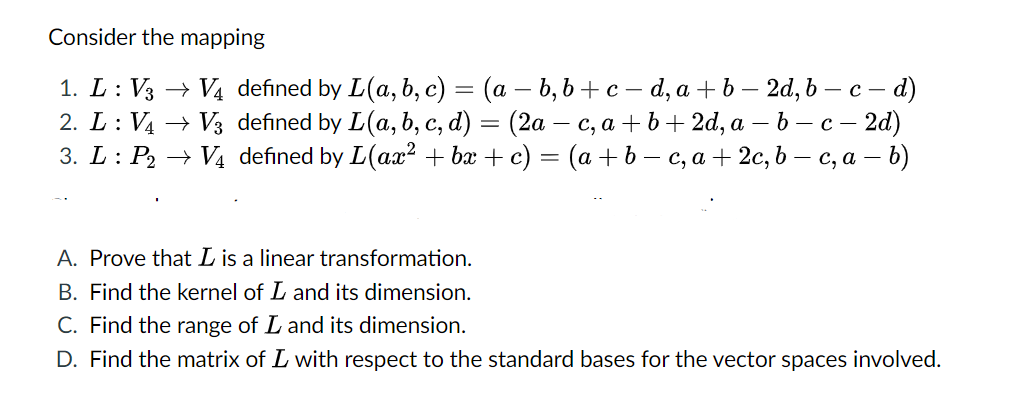1. L: V3 V4 defined by L(a, b, c) = (a - b,b+c-d, a+b-2d, b-c-d) 2. L: V4 → V3 defined by L(a, b, c, d) = (2a −c, a+b+2d, a - b - c - 2d) 3. L : P₂ → V4 defined by L(ax² + bx + c) = (a + bc, a + 2c, bc, a - b) A. Prove that I is a linear transformation. B. Find the kernel of L and its dimension. C. Find the range of L and its dimension. D. Find the matrix of L with respect to the standard bases for the vector spaces involved.
1. L: V3 V4 defined by L(a, b, c) = (a - b,b+c-d, a+b-2d, b-c-d) 2. L: V4 → V3 defined by L(a, b, c, d) = (2a −c, a+b+2d, a - b - c - 2d) 3. L : P₂ → V4 defined by L(ax² + bx + c) = (a + bc, a + 2c, bc, a - b) A. Prove that I is a linear transformation. B. Find the kernel of L and its dimension. C. Find the range of L and its dimension. D. Find the matrix of L with respect to the standard bases for the vector spaces involved.
Linear Algebra: A Modern Introduction
4th Edition
ISBN:9781285463247
Author:David Poole
Publisher:David Poole
Chapter6: Vector Spaces
Section6.4: Linear Transformations
Problem 24EQ
Related questions
Question
This easy do all

Transcribed Image Text:Consider the mapping
-
1. L: V3 → V4 defined by L(a, b, c) = (a − b, b + c −d, a + b − 2d, b − c - d)
2. L: V4 → V3 defined by L(a, b, c, d) = (2a − c, a +b+2d, a − b − c — 2d)
3. L: P₂ → V4 defined by L(ax² + bx + c) = (a + b − c, a +2c, b − c, a — b)
A. Prove that L is a linear transformation.
B. Find the kernel of L and its dimension.
C. Find the range of L and its dimension.
D. Find the matrix of L with respect to the standard bases for the vector spaces involved.
Expert Solution
This question has been solved!
Explore an expertly crafted, step-by-step solution for a thorough understanding of key concepts.
Step by step
Solved in 3 steps

Recommended textbooks for you

Linear Algebra: A Modern Introduction
Algebra
ISBN:
9781285463247
Author:
David Poole
Publisher:
Cengage Learning

Elementary Linear Algebra (MindTap Course List)
Algebra
ISBN:
9781305658004
Author:
Ron Larson
Publisher:
Cengage Learning

Linear Algebra: A Modern Introduction
Algebra
ISBN:
9781285463247
Author:
David Poole
Publisher:
Cengage Learning

Elementary Linear Algebra (MindTap Course List)
Algebra
ISBN:
9781305658004
Author:
Ron Larson
Publisher:
Cengage Learning